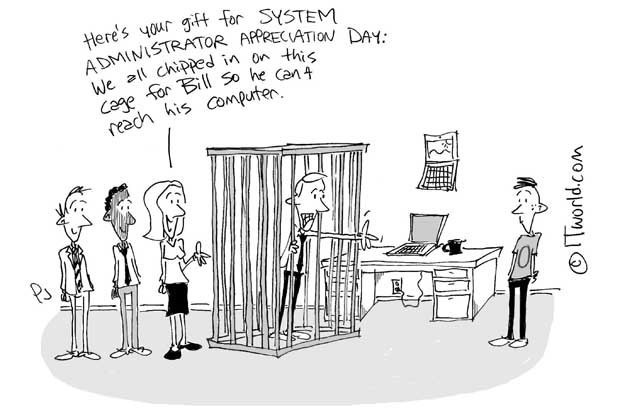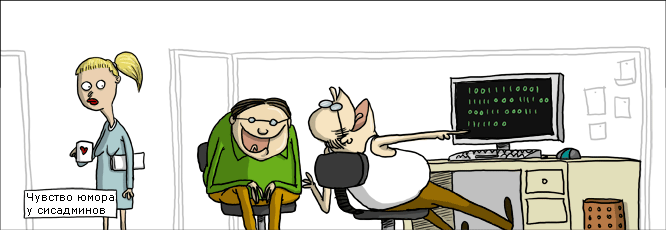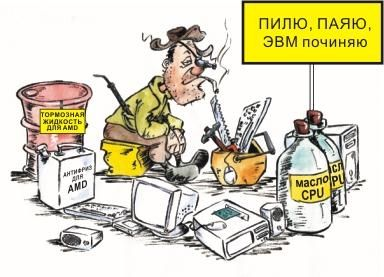Sysadmin 2017: touches to the portrait
By the beginning of 2017, almost every large company, be it a bank or a medical center, is positioning itself as an IT company. And there is a large share of truth in this - many industries are tightly tied to the application of information technology and work with narrow specialists: developers, programmers, system engineers. In such conditions, one of the most needed IT specialties is undergoing transformation - a system administrator. And the matter is not at all in DevOps, it is still far to his victorious march. The fact is that the sysadmin profession has long ceased to be the history of enikeyschik with a tambourine. Today, it requires professionalism, deep ownership of all areas of ITAM and prompt reaction to any problems, because often the company's profit and reputation depend on it. On Habré there are thousands of articles about system administration and the most subtle nuances. We want to talk about what he is, a portrait of a modern sysadmin, and what difficulties and challenges he must overcome daily.

Kitten modern admin. Other admins - other kote
Digital transformation has penetrated not only into large business and gigantic corporations, it has touched even recently the most distant from IT areas: retail, small and micro business, educational institutions. Automation of processes (implementation of CRM, ECM, ERP), the purchase of complex equipment, the desire of companies to avoid problems with pirated software - this is the minimum level of development of IT infrastructure, which is in almost all companies. However, the causes of large-scale changes lie much deeper.
In such conditions, the sysadmin ceased to be perceived as a ridiculous guy, eliminating accidents with toner or reinstalling 1C with Windows on the night before passing the annual balance. Today it is a specialist who must maintain the IT infrastructure in working condition - so that it does not affect the reduction in the quality of the work process. In fact, it is a manager for ITAM (IT asset management), a company’s IT asset management.
We in the Alloy Software team have identified several points of super power of the system administrator, which greatly facilitate the work and turn it into almost invulnerable admin of the future.
Centralized management of IT infrastructure. It is necessary that all elements be assembled into one whole and managed as a single mechanism, including the company's mobile devices. This allows you not to miss important changes, incidents, to replace outdated software or hardware in time, to respond to a critical situation. If management is decentralized, the system administrator will spend much more time, and overlaps, duplications, or downtime will continually occur within a service or IT department.
Security is a key task for a modern system administrator. In addition to security issues related to hardware and software licensing control, this includes data security, access rights, and creating backup copies. Under current risk conditions, only comprehensive measures for monitoring, detecting, protecting and preventing violations can give a reliable result.
Planning. This item seems insane - because you need to respond to the endless problems of users and work with critical situations, it is difficult to plan something in advance. However, each system administrator has a range of tasks that he performs at intervals - and they need to be planned. This also includes planning the audit and inventory, then these processes will become routine and will no longer take away the nerves and strength.
Minimize unpredictability. Behind each work computer, peripherals and other infrastructure elements are users who often make it difficult for the system administrator to work: they install unauthorized software, cracked versions of software, demolish antiviruses (they also slow down the computer!), In some cases they change components to older ones or that It happens more often and has more serious consequences. They put their equipment, for example, wireless modems, to get access to the Internet from a closed network, flash drives and external HDDs - in order to merge the necessary data, various hardware for entertainment and games on your desktop PC. As a result, there is a mass of threats in terms of information security, there is a risk of loss. It is important to adjust the monitoring process and make it transparent - so that users know exactly what actions they will be punished for and that they will not be able to hide anything, because the sysadmin has an all-seeing eye. Such measures will significantly reduce the number of incidents and problems on the part of employees.
Invisible work. Surely many of you remember the blissful moment when something spoils in the work computer, the sysadmin is sitting in your chair and idly looking for reasons, and you are drinking tea, distracting him and others from work, and legally. Today there is no place for such stories - work in many positions has become intense and intense, idle for 20-30 minutes can significantly affect the entire working process. At the same time it does not matter at all whether it is a question of development, production or sales. All employees' activities (from programming to telephony) are tied to PCs and networks, which means that a breakdown or update can paralyze it. The system administrator should, if possible, perform their tasks without taking users away from the PC.

You have a gift for the Day of the system administrator: we all threw ourselves on this cell, and now Bill will not be able to reach his computer
Economic responsibility is an unpleasant but important moment in the work of a modern system administrator. To optimize IT costs, you need to track in time the number of licenses used, the amount of software usage, regulate the use of licenses and PCs when changing staff numbers, and optimize hardware.
The system administrator must also have personal qualities that can influence the effectiveness of his work.

Source - Yaplakal
And everything would be fine if it were not for the next item of our post. The fact is that the system administrator can be regarded by employees and management as a personal PC master, and not as a key link in the management process. Well, something like this:

Source —prouderamadeus.blogspot.ru
Often, managers (especially non-IT companies) see only the direct contribution of an employee to profit: the salesman sold - revenue came, the marketer returned from the exhibition - brought the contract, the production worker - created the product that was sold. IT infrastructure is perceived solely as a recipient of the budget, which needs to be paid, and ITAM as an administrative function that does not make a significant contribution to the formation of profit. As a rule, this state of affairs persists until one of the three situations arises.
Of course, the discrepancy between what is ITAM (asset management), and how it is actually used in the company is huge. And this gap is especially noticeable in Russian companies, which in the overwhelming majority have not yet come to implement best practices. Perhaps, of all the directions, SAM (software asset management) is developed most of all in our country, and that is thanks to the rigid policies of vendors of corporate software. However, shifts in perception already exist. And there are reasons why it is worth investing in ITAM, in training system administrators, in applied software for their productive work.
When management understands the values and objectives of ITAM, it is able to build an IT service into all the processes in the company, create a functioning business support system and thereby increase overall productivity.
The Alloy Software team for many years has been creating convenient and feature-rich programs for system administrators and ITAM managers. We know firsthand how the sysadmins work and how quickly their activities are transformed.
We offer you a checklist with short tips that you should pay attention to the system administrator.
IT asset management is one of the parts of the foundation on which the company's strategy is based. Accordingly, the system administrator (or the entire IT service) must be not just engineers, but also managers and economists in order to competently carry out the budget and organizational policies of their department.
In turn, the use of specialized software helps to work quickly, respond to any technological challenges, conduct timely diagnostics and auditing. All information together provides the basis for making informed decisions in expanding or reducing IT infrastructure, helps to plan resources and simply do their job professionally.

Kitten modern admin. Other admins - other kote
Business is changing - time to change everything
Digital transformation has penetrated not only into large business and gigantic corporations, it has touched even recently the most distant from IT areas: retail, small and micro business, educational institutions. Automation of processes (implementation of CRM, ECM, ERP), the purchase of complex equipment, the desire of companies to avoid problems with pirated software - this is the minimum level of development of IT infrastructure, which is in almost all companies. However, the causes of large-scale changes lie much deeper.
- At the head of everything related to business are economic reasons. Company executives gradually began to realize that automation of labor saves resources, increases the speed of processes and ultimately brings additional profit.
') - There are many affordable and convenient technologies that allow you to develop your IT infrastructure with less cost and greater scalability: cloud services, data centers, outsourcing solutions. Moreover, the technology applies to all areas of the company: from production to accounting and sales.
- Customization comes to the fore - we need specialists who can adapt solutions and software to the needs of a particular business and competently support it. Such a process can occur on the part of the vendor and the system integrator, but no problem (but not cheaper!) When it is initiated and done from within, since the employee is always more immersed in the company's tasks. It is worth explaining. For example, a company acquires a billing system or ERP. All improvements related to the peculiarities of the business and the requirements of the divisions will be made more professional and faster by the vendor. But in the future, you will need to generate reports, adjust the time for exchanging data with other software, perhaps transfer or replicate a database, make backups, etc. - It is better to entrust these tasks to an internal employee.
- “Mobilization”, on the one hand, helped out a business that can recruit remote employees, easily deploy branches and work “in the fields”, and on the other, has created many data security problems.
- In general, with the development of cloud technologies, web services and IoT, security issues have become more acute than ever: you need to protect information from competitors, intruders, hackers, and even from your employees. The human factor has become extremely important.
- Finally, data and business information have become a valuable and costly asset, the loss of which can lead to reputational, financial, legal risks and the collapse of the company.
In such conditions, the sysadmin ceased to be perceived as a ridiculous guy, eliminating accidents with toner or reinstalling 1C with Windows on the night before passing the annual balance. Today it is a specialist who must maintain the IT infrastructure in working condition - so that it does not affect the reduction in the quality of the work process. In fact, it is a manager for ITAM (IT asset management), a company’s IT asset management.
Super power system administrator
We in the Alloy Software team have identified several points of super power of the system administrator, which greatly facilitate the work and turn it into almost invulnerable admin of the future.
Centralized management of IT infrastructure. It is necessary that all elements be assembled into one whole and managed as a single mechanism, including the company's mobile devices. This allows you not to miss important changes, incidents, to replace outdated software or hardware in time, to respond to a critical situation. If management is decentralized, the system administrator will spend much more time, and overlaps, duplications, or downtime will continually occur within a service or IT department.
Security is a key task for a modern system administrator. In addition to security issues related to hardware and software licensing control, this includes data security, access rights, and creating backup copies. Under current risk conditions, only comprehensive measures for monitoring, detecting, protecting and preventing violations can give a reliable result.
Planning. This item seems insane - because you need to respond to the endless problems of users and work with critical situations, it is difficult to plan something in advance. However, each system administrator has a range of tasks that he performs at intervals - and they need to be planned. This also includes planning the audit and inventory, then these processes will become routine and will no longer take away the nerves and strength.
Minimize unpredictability. Behind each work computer, peripherals and other infrastructure elements are users who often make it difficult for the system administrator to work: they install unauthorized software, cracked versions of software, demolish antiviruses (they also slow down the computer!), In some cases they change components to older ones or that It happens more often and has more serious consequences. They put their equipment, for example, wireless modems, to get access to the Internet from a closed network, flash drives and external HDDs - in order to merge the necessary data, various hardware for entertainment and games on your desktop PC. As a result, there is a mass of threats in terms of information security, there is a risk of loss. It is important to adjust the monitoring process and make it transparent - so that users know exactly what actions they will be punished for and that they will not be able to hide anything, because the sysadmin has an all-seeing eye. Such measures will significantly reduce the number of incidents and problems on the part of employees.
Invisible work. Surely many of you remember the blissful moment when something spoils in the work computer, the sysadmin is sitting in your chair and idly looking for reasons, and you are drinking tea, distracting him and others from work, and legally. Today there is no place for such stories - work in many positions has become intense and intense, idle for 20-30 minutes can significantly affect the entire working process. At the same time it does not matter at all whether it is a question of development, production or sales. All employees' activities (from programming to telephony) are tied to PCs and networks, which means that a breakdown or update can paralyze it. The system administrator should, if possible, perform their tasks without taking users away from the PC.

You have a gift for the Day of the system administrator: we all threw ourselves on this cell, and now Bill will not be able to reach his computer
Economic responsibility is an unpleasant but important moment in the work of a modern system administrator. To optimize IT costs, you need to track in time the number of licenses used, the amount of software usage, regulate the use of licenses and PCs when changing staff numbers, and optimize hardware.
The system administrator must also have personal qualities that can influence the effectiveness of his work.
- Attention to technical innovations. The park of equipment in modern companies is very diverse: they are different types of computers, peripherals and network equipment. Administrators must understand the features of equipment management, be aware of the role and place of each element in the network, know undocumented features and bugs (this is not a criterion for hiring, everything is learned in battle!) Of everything used in the company.
- Analytical skills. The system administrator can no longer create a network "on the knee", he should be able to design it, plan resources and be able to evaluate the effectiveness of the work of networks and systems. He gets a huge amount of information from different sources and should be able to structure and interpret it.
- Communication skills with people. Forget memes about introverts and misanthropes in IT: the system administrator interacts daily with users, management, suppliers, customers. This means that he must possess both management skills and communication skills in order to understand the problem, withstand its description in the user's language and explain the solution. If a solution is found, but not clarified, be sure that the problem will be reproduced soon.

Source - Yaplakal
- The speed of thinking and the ability to make decisions. IT infrastructure is the most important part of the business, any delay can be fraught with disastrous consequences for the company. You need to quickly find the problem and select the best way to fix it.
- Multitasking. Alas, even an entire IT service is necessarily confronted with the need to solve several parallel and unrelated tasks. Without the ability to switch and quickly focus on a new problem simply can not do.
And everything would be fine if it were not for the next item of our post. The fact is that the system administrator can be regarded by employees and management as a personal PC master, and not as a key link in the management process. Well, something like this:

Source —prouderamadeus.blogspot.ru
Yes, they themselves do not understand what they want!
Often, managers (especially non-IT companies) see only the direct contribution of an employee to profit: the salesman sold - revenue came, the marketer returned from the exhibition - brought the contract, the production worker - created the product that was sold. IT infrastructure is perceived solely as a recipient of the budget, which needs to be paid, and ITAM as an administrative function that does not make a significant contribution to the formation of profit. As a rule, this state of affairs persists until one of the three situations arises.
- Migration or software integration. Both processes are complex in terms of technology and management, require high qualifications and, as a rule, are thought of as measures to increase profits.
- Company scaling up - business is growing, new resources are needed, IT infrastructure needs to be developed and new divisions entered into it, the question arises about operational efficiency and its impact on revenue. Any scaling is a serious stress test for the IT infrastructure.
- The acute question of savings in procurement and budget cuts. Often, the backlog of savings is just in the IT service, which in fed-up times especially did not even ask about anything. Why not start saving even in these most satisfying times - a separate question.
Of course, the discrepancy between what is ITAM (asset management), and how it is actually used in the company is huge. And this gap is especially noticeable in Russian companies, which in the overwhelming majority have not yet come to implement best practices. Perhaps, of all the directions, SAM (software asset management) is developed most of all in our country, and that is thanks to the rigid policies of vendors of corporate software. However, shifts in perception already exist. And there are reasons why it is worth investing in ITAM, in training system administrators, in applied software for their productive work.
- Efficiency. By automating the entire IT infrastructure management process, or at least parts of it, you can save hundreds of man-hours and reallocate human resources to other tasks.
- Savings: on hardware, on licenses, on licensing forms, on peripheral and network equipment. It is achieved through more careful and optimized use, as well as through the planning and forecasting of the state of IT infrastructure.
- Unification of data storage and tickets. ITAM allows you to manage your IT service transparently, centrally and efficiently.
When management understands the values and objectives of ITAM, it is able to build an IT service into all the processes in the company, create a functioning business support system and thereby increase overall productivity.
Keep abreast of nerves
The Alloy Software team for many years has been creating convenient and feature-rich programs for system administrators and ITAM managers. We know firsthand how the sysadmins work and how quickly their activities are transformed.
We offer you a checklist with short tips that you should pay attention to the system administrator.
- Any task that you perform regularly requires automation: the use of specialized software or scripts. Do not be lazy and think over the solution of this issue - the time spent will more than pay off free time. In addition, automation reduces the likelihood of error and facilitates the rotation of cases between employees.
- Document the processes, create a knowledge base - it will be useful not only for you, but also help newcomers to adapt when expanding the team.
- Plan your work and tasks - in any case, everything that can be planned.
- Prepare for audits and inventory in advance, use automation tools: barcodes, stickers, tags, etc.
- Pick up an IT infrastructure management tool (pay attention to Alloy Software solutions - these are powerful universal IT management tools for industrial and office enterprises developed in accordance with international ITIL and ITSM management standards).
- Put safety first, back up regardless of whether you use the cloud or maintain your own servers.
- Constantly learn, but do not rush from technology to technology - all new products do not implement. Remember: change must have meaning and benefit, and should not be change for the sake of change.
- Use the ticket system - let users get problems and requests on their own, learn how to describe and classify them. With tickets, it is easier to track decisions and coordinate actions.
- Record the time of task execution in tickets or any other time management system.
- Bargain with your colleagues: let them not add tasks marked “Urgent. Important,” and prioritize within your requirements and deadlines.
- If you start a new project, be sure to calculate the project requirements, resources and set fractional tasks - then the implementation will be easier.
- Log all information obtained during the audit and monitoring, taking into account the time and responsible. Logging provides information about all incidents, about when they occurred for the first time.
- Constantly identify company needs for hardware and software.
IT asset management is one of the parts of the foundation on which the company's strategy is based. Accordingly, the system administrator (or the entire IT service) must be not just engineers, but also managers and economists in order to competently carry out the budget and organizational policies of their department.
In turn, the use of specialized software helps to work quickly, respond to any technological challenges, conduct timely diagnostics and auditing. All information together provides the basis for making informed decisions in expanding or reducing IT infrastructure, helps to plan resources and simply do their job professionally.
Source: https://habr.com/ru/post/321322/
All Articles